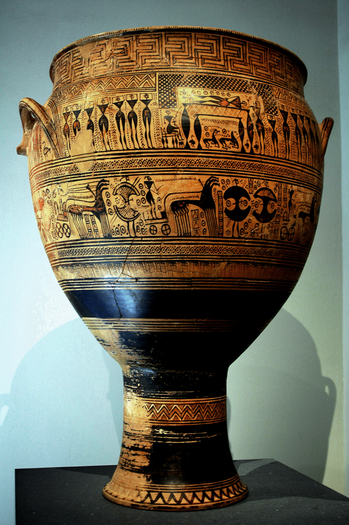Art History/Ancient Art
Ancient Egyptian Art
[edit | edit source]
As far as we know, civilization first began in the Mesopotamian river valleys of the Tigris and Euphrates in present day Iraq. Soon thereafter, it took root in the valley and delta of the Nile. The ancient Egyptian civilization was one of the longest lasting in the West. It began in approximately 3000 B.C and lasted until 300 B.C. When it came to their art, the Egyptians had a distinguished style known as frontalism. Figures created in this way are also called composite.
The features of frontalism are as follows:
- In reliefs and paintings, the head of the character is drawn in profile while the body faces frontward
- The eyes are drawn in full (even though the face is in profile)
- The legs are turned to the side with one foot in front of the other
- All of the figures, in all media, are rigid and stiff, yet the faces are calm or no expression
Although frontalism applies to the Egyptian art through thousands of years, there were slightly different rules for animals or slaves.
The Timeline of Egyptian Art
[edit | edit source]The Predynastic Period lasted from about 5000-3100 B.C. which was before Egypt became a kingdom. Many of the characteristics of their culture and art as we know it did begin during this time period.
- The pantheon of the gods was established during this time period
- The illustrations and proportions of their human figures was developed
- Egyptian imagery, symbolism, and basic hieroglyphic writing was developed
The Early Dynastic Period lasted from about 3100 - 2686 B.C., which is also known as the 1st and 2nd Dynasties. During this time, the Egyptian government was strong and supported their arts.
During the Old Kingdom - from 2686-2181 B.C., the Egyptian pyramids were built. Sculptures that appeared more natural were built. The first known portraits were done. It is at the end of the Old Kingdom when the Egyptian style made a shift toward formalized nude figures with long bodies and large eyes.
Gallery
[edit | edit source]Egyptian Art
[edit | edit source]-
Nefertiti Bust
-
Funerary mask of Tutankhamun
-
Gold Scarab
-
Mirror of the Chief of the Southern Tens Reniseneb
-
Statue of Pharaoh Mentuhotep II
-
Stele of Princess Nefertiabet eating
-
The Narmer Palette
-
Temple of Horus at Edfu
-
The Giza pyramid complex
Greek Art
[edit | edit source]-
Aphrodite of Milos
-
Winged Nike of Samothrace
-
Roman reproduction of Myron’s Discobolos in Bronze.
-
Ptolemaic mosaic of a dog with metal askos from Hellenistic Egypt.
-
An Attic red figured cup featuring a horse rider.
-
Heracles and Athena on Black figure and red figure pottery
-
Minoan Bull's Head Rhyton from Kato Zakros
-
The mysterious clay fried Phaistos Disc.
-
Attic white ground Kylix featuring Apollo with a black bird. Probably painted by the Pistoxenos Painter.
-
The Hirschfeld Krater.
-
Fragment of a gold wreath.
-
Greek statues were originally given color. This is a modern restoration attempt.
-
Temple of Hephaestus in Athens.
-
The Parthenon in Athens.
-
Theatre and Temple of Apollo at Delphi.
-
Theatre of Dionysus in Athens.
-
The Ancient Theatre of Epidaurus.
-
Theatre Mask
Roman Art
[edit | edit source]-
Augustus of Prima Porta
-
Head of an elderly Roman.
-
Roman mosaic featuring a theater mask.
-
Maison Carrée, a Roman temple located in modern France.
-
Pantheon in Rome.
Mesopotamian Art
[edit | edit source]-
Statue of Ebih-Il
-
Bull's head of the Queen's lyre from Pu-abi's grave
-
Bronze head of an Akkadian ruler, likely either Sargon of Akkad or Naram-Sin of Akkad.
-
Victory Stele of Naram-Sin
-
Assyrian Winged Bull
-
Great Ziggurat of Ur
Ancient Chinese Art
[edit | edit source]-
Just one of the multitude of statues from the Terracotta Army.
-
The Flying Horse of Gansu
-
Duanfang altar set
-
Hou Mu Wu Ding
-
One of the Bronze statues of tall humans in Sanxingdui.
Pre Columbian American Indian Art
[edit | edit source]-
Olmec Head
-
Head dress of Moctezuma II (Reproduction)
-
Zapotec Mask
-
Chichen Itza
-
Stone of the Sun
Ancient Art of Other Civilizations
[edit | edit source]-
Pyramids of Meroë
-
Greco-Buddhist state of the Buddha. This statue was crafted in Gandhara.


















































